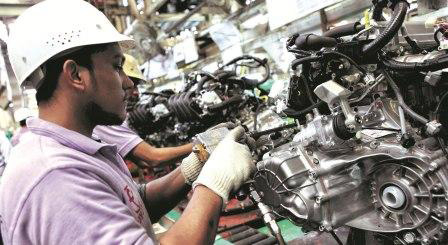
Pakistan, the sixth-most populous country in the world, is back on a growth track. The country, whose economic development has been volatile in the past, is currently witnessing a sustained upswing on the back of a series of policies and reforms to stimulate economic growth that were implemented under Prime Minister Nawaz Sharif when he came to power in June.
The 5 per cent growth in the first quarter of the country’s fiscal year, which runs from July to June, was above the central bank’s forecast of 4 per cent and significantly higher than the 2.9 per cent in the same period of the previous fiscal year, prompting a rare statement by the State Bank of Pakistan that the macroeconomic indicators were favourable and the increase in GDP growth “discernible” based on stronger industry and service sectors.
“The government is following very strict austerity measures that have not been easy to make,” said Finance Minister Mohammad Ishaq Dar at a press conference in Dubai in February. “But current trends of the last few months have been very positive in Pakistan and prices have been stable,” he added, agreeing that some measures have been politically unpopular, but were needed for the country “to change the direction of the economy ... to put us on the road of recovery and stability”.
As Pakistan looks back at decades of internal strife and political turmoil, as well as a highly unregulated shadow economy that made the government almost unable to collect taxes, the current reforms are broadly seen as unavoidable as the country continues to face serious deficiencies in basic services such as railway transportation and electric power generation that had developed in the past. Apart from that, Pakistan is suffering from dangerously low foreign currency reserves, as well as constant risks to its security.
Sharif put the focus on fiscal consolidation, tax reforms, measures to tackle the energy crisis, the restructuring and privatisation of public sector enterprises, trade policy reforms and steps to boost the investment climate. He signed a $6.7 billion (Dh24.6 billion) loan with the IMF in September to rebuild the country’s reserves after more than two years of depletion. This development loan, the first in six years, has been the major driver for Pakistan to commit to changes in the economy.
“The government and the IMF have agreed on the most important issues,” says Jeffrey Franks, the IMF’s mission chief for Pakistan. “These issues address the very large fiscal deficit, which could no longer be financed, the critically low level of international reserves and the need for structural reforms, particularly in the energy sector, to get the economy out of the low-growth trap it has been mired in for years.”
After an October visit, Franks said the reforms were broadly on track, but will take years to bear fruit, especially in improving tax collection and energy supply. In his assessment, a large part of the measures should focus on social spending for education and cash transfers to the poorest to reduce the extreme income gap in the 193-million-people country between economic hubs such as Karachi and Punjab, and rural areas.
However, Pakistan’s economy has moved forward in terms of diversification. Formerly the economy’s largest sector, agriculture has shrunk to some 21 per cent of GDP, while industry and services, including banking and finance, have grown strongly. But a major problem still persists, which is Pakistan’s chronic energy shortage due to inefficiently managed state-owned power firms and a poor distribution network.
To address this, the government turned to the Asian Development Bank and signed an agreement for a $900-million loan in February to construct a new coal-fired power plant near the Indus river, at an estimated cost of $1.5-billion.






